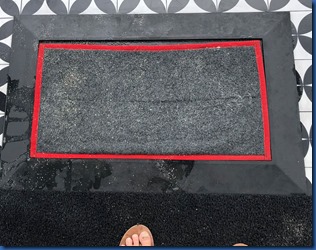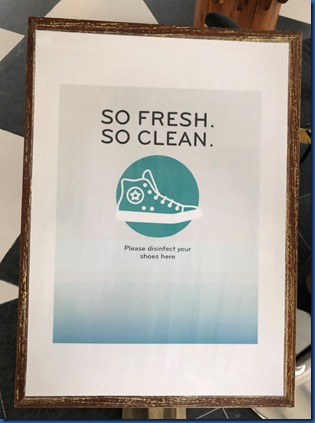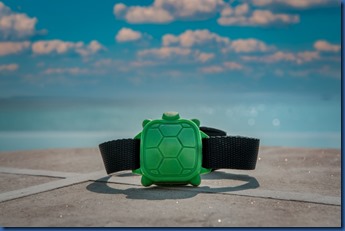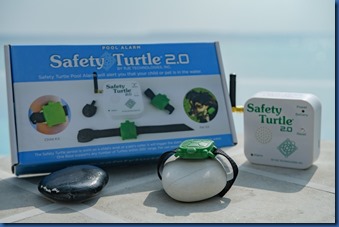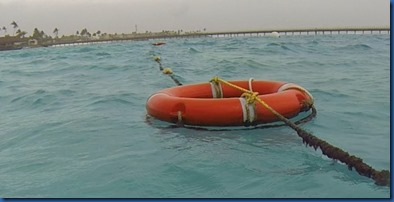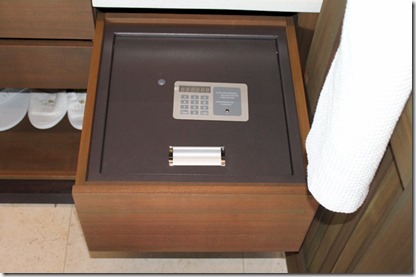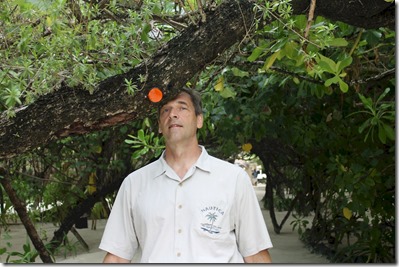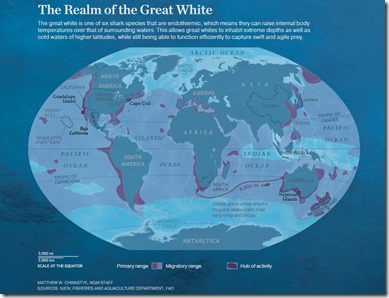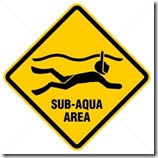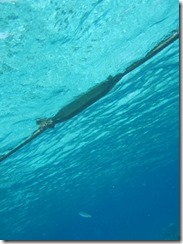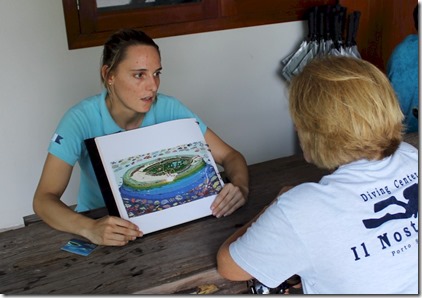Maldives might be the ‘no shoes, no news’ destination, and for soles of feet or shoes, SAii Lagoon wants to make sure they are safely sanitised. Hand gel is pretty ubiquitous in the post-pandemic world, but SAii Lagoon is making sure the other limbs are equally safe. Safety from hand to toe.
Best of the Maldives: Safety Turtle – Amilla
Even if you stay sequestered in your own villa pool, you still to have to be careful with safety around water. Especially with young ones in tow. And this is doubly the case if you have a water villa with a pool. A while back, most Maldives resorts did not allow children in water villas for fear of their falling into the ocean, but recently they have decided to let parent’s make their own decisions about safety. If your child is less mobile or you are diligent in looking after them, then there shouldn’t be any problems. But all parents know their attention can be distracted even for a moment.
For an extra measure of hi-tech protection, Amilla has procured a number of “Safety Turtle” devices which trigger an alarm at a base station (up to 200 feet away) if it gets wet. Put it on your child’s wrist to be alerted imediately if they fall into the pool or ocean. The devices are available for loan on request.
Best of the Maldives: Snorkel Safety Ring – SAii Lagoon / Hard Rock
One of the appeals of snorkeling and swimming in the Maldives is the mill pond calm waters of the sea stilled by the atoll reef topology. But any body of water, including your bathtub, can be a drowning risk. Not surprisingly, for a country 99% water, the biggest cause of fatality for guests to the country is drowning. Perhaps seduced by the placid feel, people can literally get in over their head. To help reduce the risk of snorkellers getting into trouble (or just to provide a place where they can stop and rest and maybe chat easily with their snorkel buddy), Hard Rock and SAii Lagoon have placed hi-vis floatation rings at the lagoon snorkeling spot (where they have placed a few underwater items to attract fish and provide visual interest in an area which is, and always has been, most sandy shoals.
Best of the Maldives: Biggest Safe – Velaa
Velaa puts the “safe” into “safety”. With the largest room safe we have come across in the Maldives. About 4 times the size of the conventional closet shelf safe.
In all our nearly 20 years of travelling to the Maldives, we have never lost anything in a room. I think the room staff there are amongst the most virtuous in the world. But that doesn’t mean you shouldn’t put your valuables in a safe. The biggest threat that a safe protects you against is…yourself. Being in a completely different environment and routine, it is quite easy to misplace something. Especially if you are transferring to multiple properties during your holiday. Putting all the important stuff – passports, wallets and cash, jewellery, maybe special electronics – imposes a discipline on you to put all your eggs in one basket and watch that basket. There is quite a risk that you just put something in the wrong place. And then before you know it your idyllic get-away is ruined wondering if someone has walked off with it. Simply remove all doubt and a lot of the risk by methodically locking stuff in the safe. And if you have lots of stuff, consider a stay a Velaa.
Best of the Maldives: Low Branch Warnings – Taj Exotica
Heads up! Not everywhere in the Maldives has expansive headroom. Especially since the tropical vegetation grows quite dense in places with some very low branches. The resorts try to send the paths clear of the low hanging woodwork, but on small islands, it often has few options and also wants to minimise chopping things down.
Sometimes the tropical canopy is so dense that it forms a lush awning over your sandy path. And sometimes that tropical growth is so dense that it can get right down in your face…literally. One resort with particular thick jungle canopy is Taj Exotica. And to help prevent periodic concussions for the somewhat taller guests (like me), they have affixed red reflectors onto the low branches for warning. Probably best to leave the “knocking you out” to the dazzling natural beauty.
This post has actually inspired a new category tag – “Safety”.
Maldives QI – Part X
…for “X” marks the spot where in the world the Great Whites are.
Q: When was the last shark attack in the Maldives?
A: A year ago?
Q: Buzzzzz! No. The Maldives have never had a recorded shark attack on a human.
World Tourism Day today and the Maldives stand tall (much taller than its famously low elevation) among the titans of the travel industry as a bucket list destination. And for selachophiles, the bountiful populations of a range of shark species is one of the many oceanic attractions.
Still, for a few of the more aquatically apprehensive, all these dorsal fins can evokes a number of cinematic fears brought on by everything from Jaws to Deep Blue Sea and Thunderball. In fact, nearly all species of shark keep quite a distance from diving and swimming humans. When you spend some time diving and snorkelling with them, you quickly figure out how they are the scaredy-cats of the ocean turning and fleeing at the least disturbance.
In most cases, these cartoonishly portrayed “man-eaters” are the species “Great White”. And if sharks’ docile temperament isn’t enough to re-assure you then, you can at least travel to the Maldives knowing that you won’t encounter any Great Whites. Great Whites are found pretty much all over the world east-to-west, and north-to-south. But there is one place they don’t hang out in and that’s the Indian Ocean (except for a patch off the coast of east Africa).
The Ultimate Guide to Safe Snorkeling
Today is International Water Safety Day. So time for a quick edition of Maldives QI…
Q: What is the greatest danger of water fatality in the Maldives?
A: Eaten by sharks?
Q: Buzzz…Nope (in fact, the Maldives has not had a single report of a shark attack on a human)
A: An adrenalin sport like scuba diving?
Q: Buzzz…Nope. Nearly all scuba diving is run by very high quality PADI dive centres or liveaboards with very high safety standards and one of the strongest safety records in for diving in the world (contributed by the fact that many dive sites are not overly deep and are often relatively sheltered in atolls).
The most dangerous activity is the one that seems so alluringly easy – snorkelling. It’s not that snorkeling in the Maldives is particularly dangerous per se. In fact, one could argue it is some the safest snorkelling in the world. But it is those he mill pond calm waters in often shallow depths which lull guests into a exaggerated sense of security. When water is involved, you have a serious risk to respect no matter what the situation. As the saying goes, you can drown in an inch of water in your bathtub (and some people do). So today is the ideal good occasion for a refresher on making this inviting activity as safe as it appears (and often is) easy and thrilling.
The typical contents of a snorkel bag are snorkel, fins, mask, towel, and room key. But the “safe” snorkeler might want to bring along some extra items – eg. whistle, floatation aid. And my favourite snorkelling accompaniment – a snorkel guide. Not a book or map, but a trained, proficient, resort staffer to help and support your outing. They not only will be there to assist if anything goes awry, but they know all the best places to see resident critters on the house reef and can provide lots of great information about what you are seeing.
“TravelJody”, also a top contributor to the Maldives Forum on TripAdvisor, has written a superb piece on snorkel safety “Staying Safe whilst Snorkelling!” She goes through a catalogue of possible safety concerns including…
- Currents/Tides
- CoralRock Cuts
- Boats/Motorised Water Sports
- Snorkeling Transportation
- Sun
- Marine Life
- YOU!
Her tips include…
- Use well fitting equipment
- Be careful judging distance in water
- Wear a whistle
- Snorkel with buddy
- Get instruction
A few tips that I would add include…
- Consult the experts. Every resort has a dive centre and the majority of resorts have staff marine biologists both of whom know the resort waters intimately. They can not only tell you how the water behaves and where various hazards are, but also provide insider tips on where to see the best stuff and how (eg. maybe free dive to look under a ledge).
- Don’t let the weather fool you. It’s all about the water and currents in the ocean not the air. We have snorkelled in a monsoon with an expert who knew the currents and knew the conditions in the actual ocean were fine. Conversely, a warm, bright day might seem innocuous, but some current shift or other under the surface situation could create a surprise problem.
For a superb overview, I highly recommend another gem from Kurumba’s studios – “Snorkeling Tips for Beginner for Maldives Resorts.”
The final point really concerns over-confidence. Just because it is all calm and sunny on the exterior (which is it most of the time in the Maldives) doesn’t mean that some hazards don’t exist below the surface. Some people get skittish about sharks and even fish, but the real monster of the deep is the deep itself. Deep water where people go beyond their capabilities, and get into trouble. In any water activity, the risk of drowning is an ever-present danger whether it is in a community pool or even the tranquil waters of the Maldives.
This syndrome of false confidence is the key reason why some experts on the TripAdvisors protest against the use of flotation aids in snorkelling. They feel that such aids instil confidence in the weak swimmer to go beyond their limits and going beyond you limits imposes more risk (to yourself and to the reef) than the flotation aid mitigates. I agree that over-confidence is a risk, but a floatation aid will in nearly all cases provide critical protection against the greatest risk which is drowning so do consider bringing or wearing one (but just don’t let it drop your caution).
Other references…
Happy and safe snorkeling everyone!
Best of the Maldives: Snorkel Rope – Centara Ras Fushi
While everyone’s first snorkelling question is about spotting cool stuff, their first concern should be about safe snorkelling.
One of the leaders in snorkel safety is Centara Ras Fushi. First of all, they require a swim test before guests are allowed to snorkel the house reef (other resorts like Dusit Thani do this, but it is still a rare measure). They also have the Maldives Coast Guard come and train all their resort employees including groundkeepers and housekeepers in lifesaving. A number of staff have jumped in the water and helped people needing assistance already this year.
Finally, they have stairs out of the water and onto water villa jetty placed at regular intervals. That way, if you go out snorkelling and you get tired, you can return onto the jetty relatively easily. In most resorts, you have to get entirely around the water villas and the only way you are allowed onto the jetty is if you are going to your own villa. The conventional approach is aggravating as the water villas often extend to the house reef edge. If you go snorkelling around them, then you are forced to commit to the entire distance in order to clear them and get to a beach entrance.
But what is really distinctive is Ras Fushi’s snorkel safety rope. Snorkelers can use it to grab onto in order to secure themselves and give themselves a rest. Or they can even stick entirely to it and use it to pull themselves along for a guided float across the ridge of the drop-off. This use is a benefit to another safety measure – wearing life jackets or using flotation aids. Without question, anyone who has the slightest apprehension about swimming, should consider swimming with a life jacket or floatation aid. They will help protect from the #1 causes of problems which is fatigue and panic. One does need to remember that they are not a panacea and weaker swimmers should not get a false sense of confidence just because they are using these devices. Another issue with using the devices is that they impede mobility. Therefore, the snorkel safety rope could be an ideal complement where a snorkeler is assisted in buoyancy with the floatation aid and assisted in manoeuvrability with the rope.
The rope is set just below the surface of the water so it is not visible from the island or impeding the view of those on the island (except for several discrete buoy floats, but such floats are found all around all Maldives islands marking channels, hazards, etc). They have strung the rope completely encircling the house reef. I snapped a photo (see above) when I visited. I tried taking one further back so you all could see in in perspective, but when you get further back, it actually not that visible in the open water.
One of the best snorkel “guides” in the Maldives.
Best of the Maldives: Snorkel Safety – Dusit Thani
If there is one “Best of the Maldives” innovation that I would like all resorts to emulate it is Dusit Thani’s snorkel safety programme. We were taken through it by the resort’s dive centre instructor Manon (photo above).
- REQUIRED SNORKEL BRIEFING – For starters, all guests are required to have a 15 minute snorkel briefing before snorkelling on the reef. If you have not had your briefing and are spotted snorkelling, staff will approach you and politely inform you of the policy. For us, it didn’t matter that we had snorkelled over 50 house reefs and are a PADI Advanced Open Water Diver, we still had to have the briefing.
- REQUIRED SAFETY COURSE – If you can answer three questions, then you are cleared to snorkel the Dusit Thani house reef after they have shared a few details like entries, some current tips and other basic information about the island’s surrounding waters. The questions are: (a) How does one clear a mask?, (b) How does one clear a snorkel?, and (c) How does one determine current direction? If you can’t answer the questions, the guests are requires to take a snorkel safety course (cost $55).
- REQUIRED SNORKEL TEST – After the course, you are assessed with a boat accompanying you and your instructor/guide. If you pass, you are all set to snorkel freely on the house reef.
- REQUIRED SNORKEL GUIDE – If you do not pass your snorkel proficiency test, then you are required to use a resort/dive-centre guide every time you snorkel on the house reef (cost is $25 per outing)
- TRAINED SECURITY STAFF POSTED– All of the security staff are trained in lifesaving and all 3 of the resort jetties have security staff posted. The posted house reef entry points are located near these jetties and the security staff are instructed to watch snorkelers who go out. Probably the closest thing to full time lifeguards I have seen in the Maldives. A measure I think resorts should consider (though the resort points out that these security staff are not intended as “lifeguards” and people should not depend on them for their safety).
- LIFEJACKET RECOMMENDED – It still boggles my mind that a number of quite knowledgeable Maldives experts on the Maldives TripAdvisor Forum have asserted the bizarre argument that snorkelling with a lifejacket is dangerous. I think their reasoning is along the lines of (a) “just say no” – ie. if you can’t swim well, don’t try it (nice, in principle, but in the real world people don’t really understand or respect their limitations, not to mention that this prohibition removes one of the great experiences of the Maldives from their visit), and (b) “over-confidence” – ie. the same reasoning as to why some say seat-belts are unsafe – because the sense of security makes you drive more recklessly (one may drive recklessly, but whatever the outcome of your driving, you are safer with a seat belt). Anyway, authorities like the Red Cross and PADI strongly urge the use of lifejackets when engaging in swimming activities where there is any question of swimming capacity (eg. strong swimmers in tough conditions, weak swimmers in easy conditions). The fact that Dusit Thani strongly encourages this practice is an inspired attitude in my view.
HINT FOR THE TEST – We knew the first technique for checking current, but hadn’t thought of the other two which are quite obvious on reflection…
- See which way the fish are facing (they swim into the current)
- Ask the dive centre
- Ask the boat captains.
Happy (and Safe) Snorkelling!
Best of the Maldives: Food Safety – Kanuhuraa
Despite being an exotic locale, the Maldives food is as high, as clean, and as safe a standard as you will find anywhere. The only food problem I have encountered in our many trips was friend who suffered an allergic reaction to the fresh pineapple.
But if you are particularly fussy about such considerations, then according to the Food Safety Asia organisation, Kanuhuraa is the resort for you.
“Kanuhura, Madives was awarded as ‘Full FSA recommendation’ by the Food Safety Asia Ltd, officials from the resort have said. According to a press release issued by the resort ‘Kanuhura is the first resort in Maldives among 22 resorts audited by the FSA, testing and rating all 5 Star resorts on Food Safety and Food Quality throughout the year on a monthly basis.’ “

